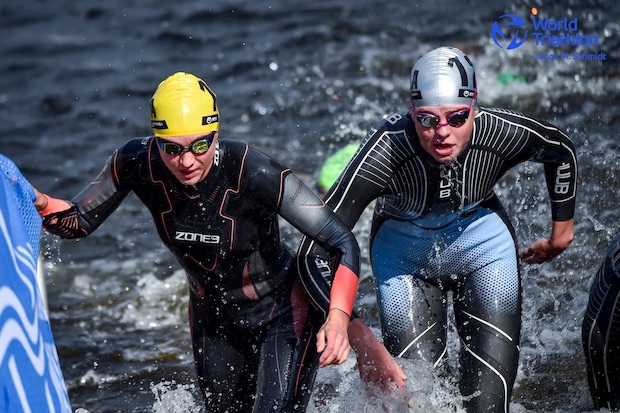
Yokohama WTCS was my first race this year. In the water, I felt like it may as well have been my first triathlon ever. I guess I’d forgotten that feeling of not knowing what is going on around you. Post-race, I got feedback from other girls whom also described it as a super chaotic swim. As someone who has worked hard to get my swim form and confidence up, I know what it’s like to feel uncomfortable in the water.
Before the race, I did a couple minutes of easy swimming followed by a handful of dive practices with a couple hard strokes. Although we always have twenty minutes of scheduled swim warm up time in World Triathlon racing, I never use the whole time. Usually I’m getting down there late anyways! But, I always do a dryland warm up routine of arm swings and lat engagement with resistance cords first. I have the same quick routine that I do before almost every swim practice. On days when we can’t get in the water to warm up, I’d just do a couple rounds of that since it’s what I’m used to. Once I’m done warming up, I usually sit down and try to relax before we line up.
Then the gun goes off and we dive into the mayhem. In Yokohama, I dove in only to have the girl next to me take her very first stroke straight into my goggle, knocking it crooked and deep into my eye. I’m sure that didn’t help with my sighting, and it hurt. There’s no moment to readjust in racing though. Only a minute or two later we then swam straight over one another. I looked up to realize I had momentarily started going the complete wrong direction. So I guess that made us even? That start was a sign of how the rest of the swim went. I felt like I was in a wide mass of girls all taking different lines. I struggled the whole swim to feel like I knew which direction I was aiming. I finished the first lap a bit behind the leaders. Those not far ahead of me caught the front group during the second lap and I was among the first to be reduced to the chase pack. A couple years ago I would’ve been delighted with that swim. Lately it’s become a common place for me to get out of the water, so naturally I’m always hoping to make that next leap closer to the front of the race.
Honestly, as crazy as the swim felt, none of it is was terribly uncommon. It’s certainly not as bad as the time I went to China for a World Cup only to kicked in the face and have my goggles break early in a 1500-meter ocean swim. That time I walked back up onto the beach where the spectators were delighted there was an athlete to take selfies with while the rest were still racing!

If you’re reading this and thinking that swimming in a triathlon is terrifying, you are definitely not alone. When I started racing I was petrified of the swim. I thought I was going to drown amongst so many girls. I’m almost embarrassed to write this, but to this day I still try to recognize moments in race swims where I’m not uncomfortable or being clawed over. I’ll have a little conversation with myself of “hey, I’m actually OK right now.” It makes the scary parts not feel like the whole experience.
I had that conversation with myself pretty much the entire time while I was swimming through the infamous tunnel at Hamburg WTCS last year. In the relay, I was the first leg and my teammates suggested I choose the inside start position on the pontoon. I was standing on the pontoon confused why all the other athletes lined up as far outside as they could. For the relay swim, you go under a dark bridge, around the bridge pillar on the far side, and come back under the bridge on the other side of the pillar. It was only after the race that my teammates explained how enough girls have been shoved into the wall of the dark tunnel during the swim that many are too afraid to take the inside line. Those are the stories you don’t need to hear until after the race. Thankfully I made it through unscathed.

Like anything, becoming more confident in open water takes practice. I am one of those crazy people who swam in lakes for months straight during 2020. Like, I did my entire swim training as normal, just in a lake. I was living in Victoria, British Colombia at the time and there were not one, but multiple, gorgeous, calm lakes to choose from. I’d previously avoided too much open water swimming. Coming from the pool and knowing the pace of every 50, I didn’t like the unknowns around my paces and distances in open water.
However, once I was forced into it long enough to find my rhythm in the lake, I absolutely loved it. I would go to the lake in the morning far more excited to jump in than I ever do at the pool now. Even though I spent probably half my time alone and the other half with just a couple swim partners, it massively helped my comfort and awareness in open water. That awareness seemed to translate really well into race swimming even when surrounded by flying hands and feet. Since then, I haven’t lived anywhere with nearly as good of access to open water, but it’s something I’d really like to incorporate into my training more.
